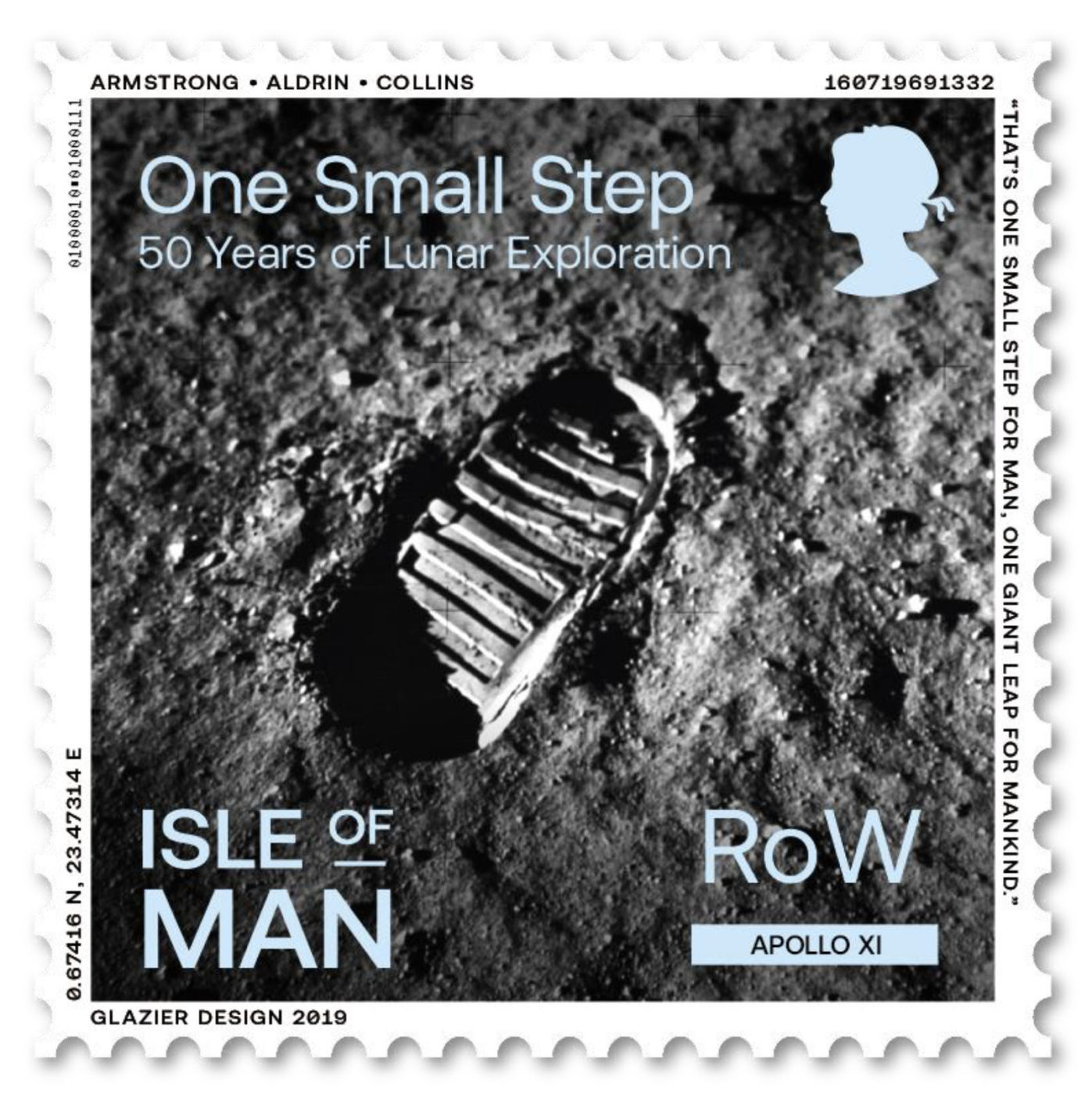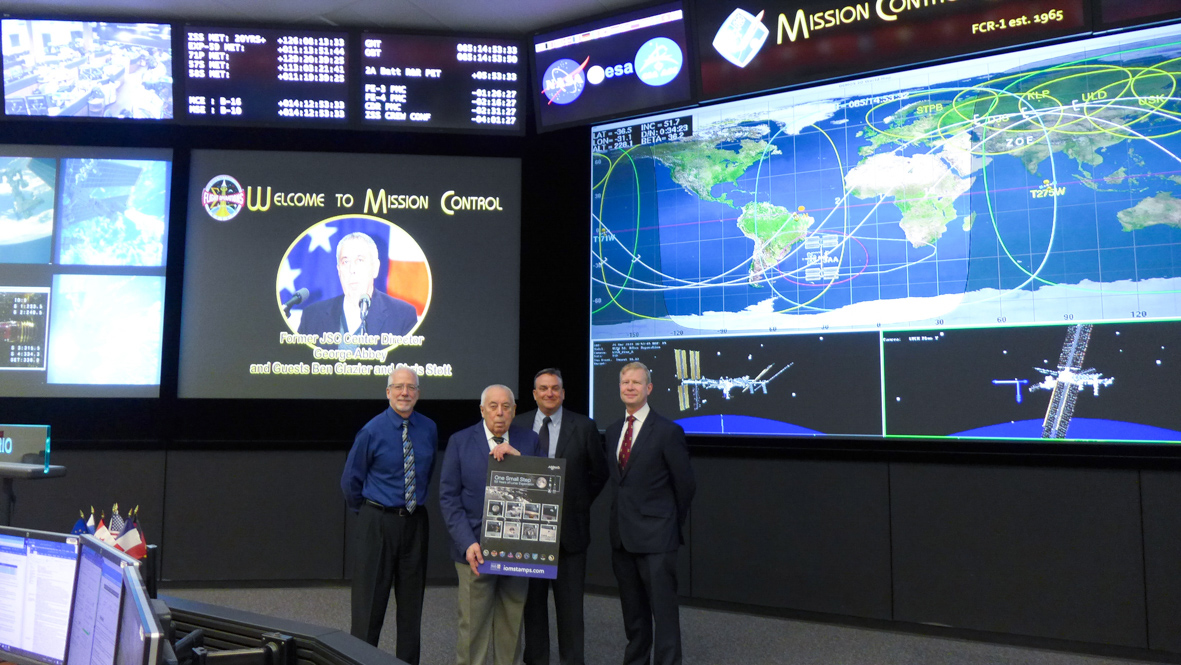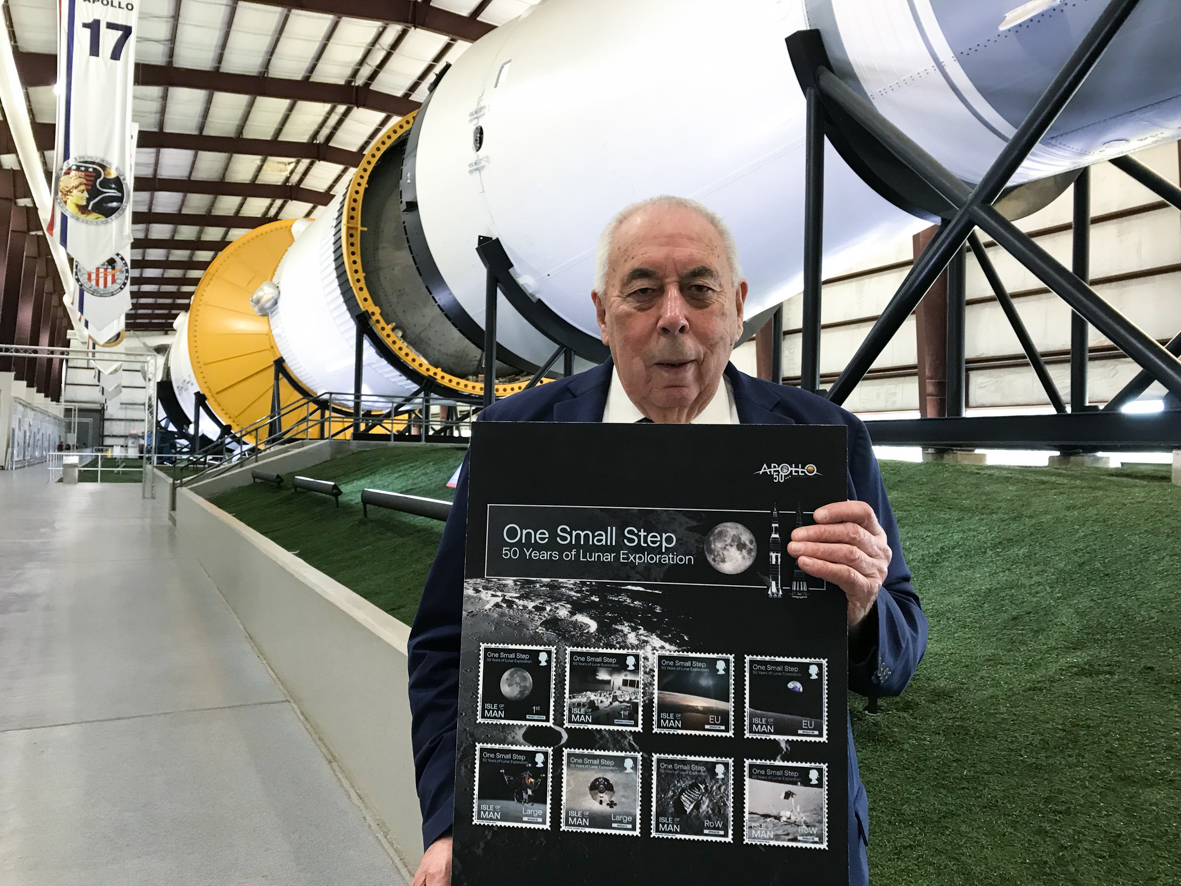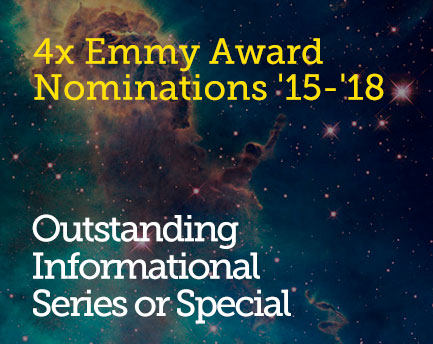May 18, 2019 9:00 am
Designing Moon Landing Anniversary Stamps and Visiting NASA
Today’s guest post is something a little different. It’s by StarTalk fan Ben Glazier, whose company, Glazier Design, created the Moon Landing 50th Anniversary stamps for the Isle of Man Post Office, as commissioned by Maxine Cannon. Maxine arranged a visit to NASA through Chris Stott of ManSat, to present the stamps to George Abbey, Former Center Director of the Johnson Space Center. This is Ben’s story about that project and that trip, which we thought many of you would find interesting. Ben also asked us to let you all know that he doesn’t benefit from the sale of the stamps. According to Ben, “We designed them and got paid a set (small!) government fee.”

The first great Space Race started back in the 1950s when the Russians put the Sputnik satellite into space, followed by manned flights. On 12th April 1961, Yuri Gagarin became the first human in space. America responded by founding NASA and starting the research and missions that led up to the Apollo Program and inevitably the first people to walk on the Moon. For the last ten years we have been in a new Space Race as SpaceX, Virgin Galactic, Blue Horizons, Boeing Starliner, and others have been racing into the commercial space sector. China has landed a craft on the Moon and established an unmanned presence; Israel, India and Japan also have advanced space programs, and private companies are starting to exploit space and the potential for revenue it holds.
At Glazier Design we have been watching the new Space Race with interest, envy and amazement, and for the last few years it has become part of our work. We had the honor of designing for Professor Stephen Hawking, creating the branding for his Foundation, helping to launch his ‘Stephen’s List’ campaign and designing the ‘Einstein to Hawking: 100 Years of General Relativity’ postage stamps. That led us to become more involved with science and tech clients and fueled some of the work we created for the Xerox Corporation. We have worked on graphic design for innovative drone projects and a host of other tech work, but nothing compares to the space industry, so it was an honor to be able to create the Moon Landing Stamps to mark fifty years since Apollo 11’s historic mission.
While creating the Moon Landing 50th Anniversary stamps, entitled ‘One Small Step,’ our designers were advised by former JSC Center Director George Abbey and others at NASA, who helped with the facts, figures and imagery from the Apollo missions.
We have hidden quotes from each of the missions, GPS references on Earth and the Moon, the names of crew and people important to the missions, and tributes to some who gave their lives in the stamps; some are so tiny that you will need to magnify them to see them, but that is the art of stamp design, to take as much information as possible and compress it into a 40mm square, while retaining beauty and functionality.
You can see the stamps in detail at www.moonlandingstamps.com, with all the explanations.
I recently visited NASA Johnson Space Center to launch the stamps with Chris Stott of ManSat, and in a display of Texan and American hospitality, we were given an amazing welcome in Houston by Mr. Abbey and the team at NASA, and by Shuttle Astronaut Dr. Bonnie Dunbar and others. We were invited onto the floor of the International Space Station Mission Control and presented sets to the current Center Director Mark Geyer and Flight Control for the ISS.

In Mission Control: Mark Geyer, George Abbey, Chris Stott, and Ben Glazier. Photo Credit: Ben Glazier.
Every minute of our trip to NASA was filled with discovery, and this brief immersion into the world of space left me yearning for more. A few years ago, we got to send a Christmas card from Professor Hawking to the ISS, and although we can’t say where, we have other designs in space; it fills us with a sense of pride (and a nerdy sense of satisfaction) to know that we have gone ‘off-planet,’ but where next? I think it must be Mars. Space is indeed addictive.
The fuller story of the visit to NASA Johnson Space Center
NASA Johnson Space Center is a vast campus that belongs to Rice University. The land was donated to Rice by a Texan oil billionaire and is on a 99-year lease to NASA. It has a truly campus feel, with sixties and seventies brutalist and utilitarian architecture spread out across a large area, interspersed with more interesting installations and the iconic Mission Control frontage. It is also a nature reserve with wild alligators, deer, tortoises and snakes; technically, public have access to roam as it is a public park, although this isn’t encouraged.
At the main entrance to JSC is a public museum where more than 8,000 visitors a day visit an interactive learning centre that includes real artifacts and exhibits from the history of NASA as well as learning facilities where groups attend talks and events. The building is packed with history, from moon lander tester vehicles, to the Apollo 17 capsule, and even a piece of moon rock that visitors can touch.
For our first tour of JSC we visited the Christopher C. Kraft Mission Control Building. This monolithic structure has no windows on the front side, and on a beautiful spring day was imposing against the Houston sky. In the entry hall, several of the control desks from the Apollo 11 Mission sit behind a security rope; the phone handsets and headpieces are attached to the unlit panels as if they had just been dropped. The main Mission Control room for Apollo 11 is being given a historically accurate refurbishment as a part of the Apollo 11 50th Anniversary celebrations, ahead of a visit by Vice President Mike Pence in July.
We were taken into the observation gallery for the Mission Control White Room, a fully equipped training room, where ground crews controlling the ISS have an opportunity to train in an as-real situation. The giant screens and TV monitors display the feeds and audio from the ISS and training crews rotate on shifts preparing for their flight control missions. White room has been used as Mission Control for many missions but has a big future in the commercial space sector as companies including SpaceX, Blue Horizons, Boeing and Virgin Galactic will be able to control their missions to the ISS, the Moon and beyond to Mars using NASA infrastructure. We took blow-up stamp boards with us and it was great to see the One Small Step stamps so close to where the action took place fifty years ago.
We spent most of our time that day in the Saturn V building, where a real Saturn rocket, most of which was supposed to be for Apollo 18, has been fully restored and put on display in a climate-controlled building. The sheer scale of the Saturn V rocket is hard to comprehend, let alone to explain; at 111 meters (363 feet), it is taller than the Statue of Liberty. Each of the five F1 Engines has a 3.7m (12’3”) diameter and provided 1.5 million pounds of thrust. It is easy to forget the fragile human element, the three astronauts, sat atop this vast machine in a tiny capsule and were blasted into space by a total 7.5 million pounds of thrust from the engines far beneath them.
Having spent the day at NASA, I got in touch with George Abbey and arranged to meet for dinner – but first went for a cool beer at Chelsea Wine Bar in Clear Lake where we met John Stoops, the barman, who is related to Ellen Ochoa, former Center Director of JSC and the first Hispanic woman in space. Talking to a neighbor in the bar we found that he had a company developing and testing plumbing for the ISS – everyone there had a family connection to NASA and relied in some way on the space industry.
I got a call from Mr. Abbey, who said to meet him at Villa Capri, a favorite with NASA locals, that has served food to many astronauts and their families over the years. Dr. Bonnie Dunbar, head of the Association of Space Explorers, joined us for dinner. As a Space Shuttle astronaut, Dr. Dunbar spent more than fifty days in space, but she also served in many high-profile roles in NASA, working on Skylab, the Space Shuttle, and the ISS. Dr. Dunbar spoke about the incredibly close community of astronauts that she represents – the requirement for membership of the ASE is to have completed one orbit of Earth in space, so this is a select membership. She also spoke about the number of women in the space industry and, although the balance could be better, there are many women astronauts and there is a steady stream of new women coming in. Dr. Dunbar emphasized, however, the importance of STEM education to get the next generation of female engineers into the space program. As an engineer herself, she is the perfect person to inspire this new generation.
George Abbey joined us for dinner. We had exchanged many emails and phone calls while he wrote the text for the Moon Landing booklet, relying on his incredibly wide, accurate and complete knowledge of the space program. His insight has been instrumental in choosing the images and facts for the stamps and he is clearly still heavily involved in advising many organizations. He has firm opinions on the realism of efforts to get to Mars, why we should or shouldn’t go, what we could be doing on the Moon, and how the safety of astronauts was always his, and NASA’s, first concern.
Visiting NASA Johnson Space Center Mission Control
Former JSC Center Director George Abbey had arranged for us to take a few pictures of the Moon Landing 50th Anniversary Stamps at NASA with Chris Stott of ManSat, without whose contacts, the entire issue would have been impossible. Mr. Abbey met us at the front gate and Stephanie Castillo, Assistant to the Director, took us to the Christopher J. Kraft Jr Mission Control building at Johnson Space Center, into the observation gallery of the International Space Station Mission Control room, where we watched the team directing operations on the ISS.
We were watching the robotic arm moving on the screens when the display changed to a picture of Mr. Abbey and a message saying “Welcome former JSC Center Director George Abbey and guests Ben Glazier and Chris Stott.” We were joined in the gallery by Mark Geyer, current JSC Center Director; we gave an explanation of the stamps and, as we were talking, the door at the side of the gallery opened and a former Flight Director came out to say that we had been invited onto the floor of Mission Control, to see the team at work and meet the Flight Director in charge.
We went through the secure doors, into the main control room, and after spending a little while taking photos next to the real life ‘Ground Control,’ we were introduced to the Flight Director to present him with a set of stamps. He described the current operation to replace the old Space Station batteries with new lithium-ion batteries that are much lighter, charge faster, and give a more reliable power source. It has taken three years to get the batteries up to the ISS, a major operation that would require an EVA set in the next two days.
It was an incredible honor to be invited onto the floor, and we are most grateful to all at NASA for their hospitality and generosity; our visit happened on the day when Vice President Mike Pence announced that the US would be sending astronauts back to the surface of the moon within five years.
After leaving the control room, we continued our tour of the facility, then went to see the beautifully restored Saturn V rocket that was originally meant to be Apollo 18, this time with a personal tour and introduction from someone who was heavily involved in the missions. In an era when every single aspect was new knowledge, untried science, experimentation and innovation, the Apollo missions stand as an example of what the brightest and bravest minds in humanity are capable of.
Mr. Abbey gave a personal description of every Apollo Mission, starting with Apollo 1, where he lost three good friends, and up through all the missions, including a first-hand account of how the team managed to rescue the crew of Apollo 13. He described in detail how every aspect of the Apollo missions was designed to ensure the crew survived; the respect for life in all NASA programs, where a zero loss is the standard aim, is summed up by the phrase at NASA that ‘failure is not an option.’ He described how, when the Apollo 1 capsule burnt out killing the crew, NASA was forced to innovate in an incredibly short time. The fire had been caused by nylon insulation in a 100% oxygen atmosphere, where one spark had ignited the interior of the capsule. The door had proved impossible to open and the crew died of smoke inhalation and asphyxiation. George lost three close friends and colleagues, but described how immediately after the fire, NASA set about designing new flame-retardant materials – the same materials that are now used for kids’ pyjamas and interior furnishings. As with so much space innovation, the loss of those lives and the consequent advance in science benefitted the whole world.

George Abbey with the Apollo 11 50th Anniversary stamps in the Saturn V hangar at Johnson Space Center. Photo Credit: Ben Glazier.
When we returned to the hotel, the television in the foyer was showing a breaking news feed that Vice President Mike Pence had announced that US astronauts, in a US spacecraft and lander, would return to the moon within five years; there was clear excitement that this was a rebirth of NASA’s aims and the future of Houston in our modern space race would be secure. It could not have been better timed.
Space is a place where most of us know we most likely will not go, so it has an irresistible draw; like most humans, we look at the unclimbable mountain and think, ‘there must be a way’. When President Kennedy announced the Apollo program at Rice University, he famously said, “We do these things, not because they are easy, but because they are hard.” That human spirit of conquering the unachievable is what drives our species and wow, has it been evident recently!
Get the most out of StarTalk!
Ad-Free Audio Downloads
Priority Cosmic Queries
Patreon Exclusive AMAs
Signed Books from Neil
Live Streams with Neil
Learn the Meaning of Life
...and much more

 Become a Patron
Become a Patron

